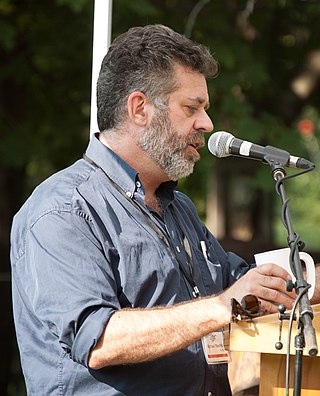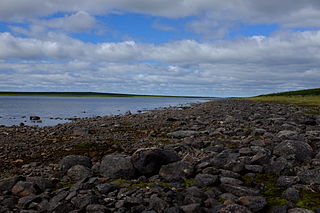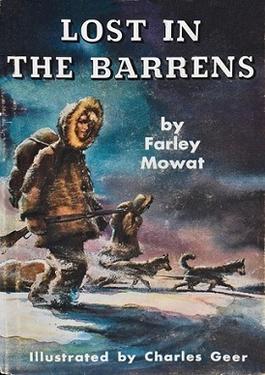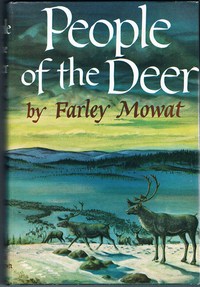
Farley McGill Mowat, was a Canadian writer and environmentalist. His works were translated into 52 languages, and he sold more than 17 million books. He achieved fame with the publication of his books on the Canadian north, such as People of the Deer (1952) and Never Cry Wolf (1963). The latter, an account of his experiences with wolves in the Arctic, was made into a film of the same name released in 1983. For his body of work as a writer he won the annual Vicky Metcalf Award for Children's Literature in 1970.

Never Cry Wolf is a fictional account of the author's subjective experience observing wolves in subarctic Canada by Farley Mowat, first published in 1963 by McClelland and Stewart. It was adapted into a film of the same name in 1983. It has been credited for dramatically changing the public image of the wolf to a more positive one.
New Journalism is a style of news writing and journalism, developed in the 1960s and 1970s, that uses literary techniques unconventional at the time. It is characterized by a subjective perspective, a literary style reminiscent of long-form non-fiction. Using extensive imagery, reporters interpolate subjective language within facts whilst immersing themselves in the stories as they reported and wrote them. In traditional journalism, however, the journalist is "invisible"; facts are reported objectively.

Michael Redhill is an American-born Canadian poet, playwright and novelist. He also writes under the pseudonym Inger Ash Wolfe.

One Dead Indian: The Premier, the Police, and the Ipperwash Crisis is a book by Canadian investigative journalist Peter Edwards about the 1995 Ipperwash Crisis and the shooting death of aboriginal land claims protester Dudley George by the Ontario Provincial Police on September 7, 1995. It was first published by Stoddart in 2001 and reprinted several times and published as an ebook.

Whale Cove, is a hamlet located 74 km (46 mi) south southwest of Rankin Inlet, 145 km (90 mi) northeast of Arviat, in the Kivalliq Region, Nunavut, Canada, on the western shore of Hudson Bay.
The Law of Life is a term coined by author Farley Mowat in his 1952 book People of the Deer, and popularized by Daniel Quinn, to denote a universal system of various natural principles, any of which tend to best foster life—in other words, any of which best guides behavior that tends toward the reproductive success and survival of some particular gene pool. The idea posits that, in general, the most fit organisms instinctively behave according to some natural rule. Since every organism has some instinctive "law" it can follow to be the most reproductively successful, this very notion is a sort of law itself, true of all living beings: thus, the Law of Life.

Ennadai Lake is a lake in the Kivalliq Region, Nunavut, Canada. It is 84 km (52 mi) long, and 4.8 to 22.5 km wide. It is drained to the north by the Kazan River. A 615 km (382 mi) section of the Kazan River from the outlet of Ennadai Lake to Baker Lake, was designated as a part of the Canadian Heritage Rivers System in 1990.

The Snow Walker is a 2003 Canadian survival drama film written and directed by Charles Martin Smith and starring Barry Pepper and Annabella Piugattuk. Based on the short story Walk Well, My Brother by Farley Mowat, the film is about a Canadian bush pilot whose life is changed through an encounter with a young Inuk woman and their challenge to survive the harsh conditions of the Northwest Territories following an aircraft crash. The film won six Leo Awards, including Best Lead Performance by a Male, and was nominated for nine Genie Awards, including Best Motion Picture, Best Performance by an Actor, Best Performance by an Actress, and Best Adapted Screenplay.

Never Cry Wolf is a 1983 American drama film directed by Carroll Ballard. The film is an adaptation of Farley Mowat's 1963 autobiography of the same name and stars Charles Martin Smith as a government biologist sent into the wilderness to study the caribou population, whose decline is believed to be caused by wolves, even though no one has seen a wolf kill a caribou. The film also features Brian Dennehy and Zachary Ittimangnaq. It was the first Disney film to be released under the new Walt Disney Pictures label. The film was released on October 7, 1983, for a limited distribution, and in the regular theaters on January 27, 1984.
Thomas Edward Lee (1914–1982) was an archaeologist for the National Museum of Canada in the 1950s and discovered Sheguiandah on Manitoulin Island. Public interest in the find contributed to passage in Ontario of a bill to protect archeological sites. While working with Laval University's Centre for Northern Studies, Lee discovered the Cartier Site on the Ungava Peninsula in Quebec.
The Ahiarmiut ᐃᓴᓪᒥᐅᑦ [ihalmiˈut] or Ihalmiut or are a group of inland Inuit who lived along the banks of the Kazan River, Ennadai Lake, and Little Dubawnt Lake, as well as north of Thlewiaza River, in northern Canada's Keewatin Region of the Northwest Territories, now the Kivalliq Region of present-day Nunavut.
Kikkik was an Inuit woman who in 1958 was charged with, but acquitted of, murder, child neglect and causing the death of one of her children. Her story was told by Farley Mowat.
Nueltin Lake straddles the Manitoba-Nunavut border in Canada. The lake, which has an area of 2,279 km2 (880 sq mi), is predominantly in Nunavut's Kivalliq Region, and on the Manitoba side there is the Nueltin Lake Airport which serves the fishing lodge. The lake is split into two parts by a set of narrows. It is drained by the Thlewiaza River.

Caribou Inuit, barren-ground caribou hunters, are Inuit who live west of Hudson Bay in Kivalliq Region, Nunavut, between 61° and 65° N and 90° and 102° W in Northern Canada. They were originally named "Caribou Eskimo" by the Danish Fifth Thule Expedition of 1921–1924 led by Knud Rasmussen. Caribou Inuit are the southernmost subgroup of the Central Inuit.

Angikuni Lake is a lake in Kivalliq Region, Nunavut, Canada. It is one of several lakes located along the Kazan River; Ennadai Lake is to the south and Yathkyed Lake is to the north.

Lost in the Barrens is a children's novel by Farley Mowat, first published in 1956. Later editions used the title Two Against the North.
Finding Farley is a 2009 documentary directed by Leanne Allison as she and her husband Karsten Heuer travel across Canada in the literary footsteps of the Canadian writer Farley Mowat.

Dust Tracks on a Road is the 1942 autobiography of black American writer and anthropologist Zora Neale Hurston.
Kai Cheng Thom is a Canadian writer and former social worker. Thom, a non-binary trans woman, has published four books, including the novel Fierce Femmes and Notorious Liars: A Dangerous Trans Girl's Confabulous Memoir (2016), the poetry collection a place called No Homeland (2017), a children's book, From the Stars in The Sky to the Fish in the Sea (2017), and I Hope We Choose Love: A Trans Girl's Notes from the End of the World (2019), a book of essays centered on transformative justice.












